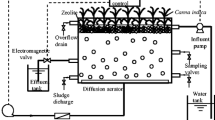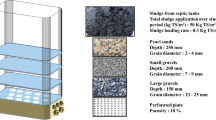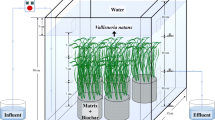Abstract
The vegetation-activated sludge process (V-ASP) has been proved to be an environment-friendly decentralized wastewater treatment system with extra esthetic function and less footprint. However, the effects of low temperature on the treatment performance of V-ASP and related improvement methods are rarely investigated, up to now. In this work, the effect of low temperature on nitrification in V-ASP was comprehensively investigated from overall nitrification performance, substrate utilization kinetics, functional enzymatic activities, and microbial community structure shift by comparison with conventional ASP. Bio-augmentation methods in terms of single-time nitrifier-enriched biomass dosage were employed to improve nitrification efficiency in bench- and full-scale systems. The experiment results demonstrated that the NH4 +–N removal efficiency in V-ASP system decreased when the operational temperature decreased from 30 to 15 °C, and the decreasing extent was rather smaller compared to ASP, as well as ammonium and nitrite oxidation rates and enzymatic activities, which indicated the V-ASP system possesses high resistance to low temperature. With direct dosage of 1.6 mg nitrifier/gSS sludge, the nitrification efficiency in V-ASP was enhanced dramatically from below 50% to above 90%, implying that bio-augmentation was effective for V-ASP whose enzymatic activities and microbial communities were both also improved. The feasibility and effectiveness of bio-augmentation was further confirmed in a full-scale V-ASP system after a long-term experiment which is instructive for the practical application.









Similar content being viewed by others
References
Ai C, Liang GQ, Sun JW, Wang XB, He P, Zhou W (2013) Different roles of rhizosphere effect and long-term fertilization in the activity and community structure of ammonia oxidizers in a calcareous fluvo-aquic soil. Soil Biol Biochem 57:30–42. https://doi.org/10.1016/j.soilbio.2012.08.003
Anteo SD, Mannucci A, Meliani M, Verni F, Petroni G, Munz G, Lubello C, Mori G, Vannini C (2015) Nitrifying biomass characterization and monitoring during bio-augmentation in a membrane bioreactor. Environ Technol 36(24):3159–3166. https://doi.org/10.1080/09593330.2015.1055818
APHA (2005) Standard Methods for the Examination of Water and Wastewater, 21st edn. American Public Health Association, Washington, DC
Awolusi OO, Nasr M, Kumari S, Bux F (2016) Artificial intelligence for the evaluation of operational parameters influencing nitrification and nitrifiers in an activated sludge process. Microb Ecol 72(1):49–63. https://doi.org/10.1007/s00248-016-0739-3
Bouchez T, Patureau D, Delgenes JP, Moletta R (2009) Successful bacterial incorporation into activated sludge flocs using alginate. Bioresour Technol 100(2):1031–1032. https://doi.org/10.1016/j.biortech.2008.07.028
Caselles-Osorio A, García J (2007) Impact of different feeding strategies and plant presence on the performance of shallow horizontal subsurface-flow constructed wetlands. Sci Total Environ 378(3):253–262. https://doi.org/10.1016/j.scitotenv.2007.02.031
Chen YG, Wang DB, Zheng X, Li X, Feng LY, Chen H (2014) Biological nutrient removal with low nitrous oxide generation by cancelling the anaerobic phase and extending the idle phase in a sequencing batch reactor. Chemosphere 109:56–63. https://doi.org/10.1016/j.chemosphere.2014.02.011
Chen Q, Ni JR, Ma T, Liu T, Zheng MS (2015) Bio-augmentation treatment of municipal wastewater with heterotrophic-aerobic nitrogen removal bacteria in a pilot-scale SBR. Bioresour Technol 183:25–32. https://doi.org/10.1016/j.biortech.2015.02.022
Chiemchaisri C, Yamamoto K (1993) Biological nitrogen removal under low temperature in a membrane separation bioreactor. Water Sci Technol 28:325–333
Choi E, Rhu D, Yun Z, Lee E (1998) Temperature effects on biological nutrient removal system with weak municipal wastewater. Water Sci Technol 37:219–226
Collins B, McArthur JV, Sharitz RR (2004) Plant effects on microbial assemblages and remediation of acidic coal pile runoff in mesocosm treatment wetlands. Ecol Eng 23(2):107–115. https://doi.org/10.1016/j.ecoleng.2004.07.005
Cui D, Li A, Qiu T, Cai R, Pang CL, Wang JH, Yang JX, Ma F, Ren NQ (2014) Improvement of nitrification efficiency by bio-augmentation in sequencing batch reactors at low temperature. Front Environ Sci Eng 8(6):937–944. https://doi.org/10.1007/s11783-014-0668-7
Dulkadiroglu H, Cokgor EU, Artan N, Orhon D (2005) The effect of temperature and sludge age on COD removal and nitrification in a moving bed sequencing batch biofilm reactor. Water Sci Technol 51(11):95–103
Edwards KR, Čižková H, Zemanová K, Šantrčková H (2006) Plant growth and microbial processes in a constructed wetland planted with Phalaris arundinacea. Ecol Eng 27(2):153–165. https://doi.org/10.1016/j.ecoleng.2006.02.004
Gao JQ, Wang WL, Guo X, Zhu SF, Chen SH, Zhang RQ (2014) Nutrient removal capability and growth characteristics of Iris sibirica in subsurface vertical flow constructed wetlands in winter. Ecol Eng 70:351–361. https://doi.org/10.1016/j.ecoleng.2014.06.006
Groeneweg J, Sellner B, Tappe W (1994) Ammonia oxidation in nitrosomonas at NH3 concentrations near k m : effects of pH and temperature. Water Res 28(12):2561–2566. https://doi.org/10.1016/0043-1354(94)90074-4
Guo JH, Peng YZ, Huang HJ, Wang SY, Ge SJ, Zhang JR, Wang ZW (2010) Short- and long-term effects of temperature on partial nitrification in a sequencing batch reactor treating domestic wastewater. J Hazard Mater 179(1-3):471–479. https://doi.org/10.1016/j.jhazmat.2010.03.027
Head MA, Oleszkiewicz JA (2004) Bio-augmentation for nitrification at cold temperatures. Water Res 38(3):523–530. https://doi.org/10.1016/j.watres.2003.11.003
Herman DJ, Johnson KK, Jaeger CH, Schwartz E, Firestone MK (2006) Root influence on nitrogen mineralization and nitrification in Avena barbata rhizosphere soil. Soil Sci Soc Am J 70(5):1504–1511. https://doi.org/10.2136/sssaj2005.0113
Huang J, Cai WS, Zhong QS, Wang SH (2013) Influence of temperature on micro-environment, plant eco-physiology and nitrogen removal effect in subsurface flow constructed wetland. Ecol Eng 60:242–248. https://doi.org/10.1016/j.ecoleng.2013.07.023
Keener WK, Arp DJ (1993) Kinetic studies of ammonia monooxygenase inhibition in Nitrosomonas europaea by hydrocarbons and halogenated hydrocarbons in an optimized whole-cell assay. Appl Environ Microb 59:2501–2510
Kim YM, Park D, Lee DS, Park JM (2008) Inhibitory effects of toxic compounds on nitrification process for cokes wastewater treatment. J Hazard Mater 152(3):915–921. https://doi.org/10.1016/j.jhazmat.2007.07.065
Lauchnor EG, Semprini L (2013) Inhibition of phenol on the rates of ammonia oxidation by Nitrosomonas europaea grown under batch, continuous fed, and biofilm conditions. Water Res 47:4629–4700
Li YF, Peng L, Ngo HH, Guo WS, Wang DB, Pan YT, Sun J, Ni BJ (2016a) Evaluation of nitrous oxide emission from sulfide- and sulfur-based autotrophic denitrification process. Environ Sci Technol 50(17):9407–9415. https://doi.org/10.1021/acs.est.6b02202
Li YF, Yuan XZ, ZB W, Wang H, Xiao ZH, Wu Y, Chen XH, Zeng GM (2016b) Enhancing the sludge dewaterability by electrolysis/electrocoagulation combined with zero-valent iron activated persulfate process. Chem Eng J 303:636–645. https://doi.org/10.1016/j.cej.2016.06.041
Long B, Yang CZ, WH P, Yang JK, Jiang GS, Li CY, Liu FB, Dan JF, Zhang J, Zhang L (2016) Rapid cultivation of aerobic granule for the treatment of solvent recovery raffinate in a bench scale sequencing batch reactor. Sep Purif Technol 160:1–10. https://doi.org/10.1016/j.seppur.2015.12.056
Otte S, Schalk J, Kuenen JG, Jetten MSM (1999) Hydroxylamine oxidation and subsequent nitrous oxide production by the heterotrophic ammonia oxidizer Alcaligenes faecalis. Appl Microbiol Biotechnol 51(2):255–261. https://doi.org/10.1007/s002530051390
Patureau D, Helloin E, Rustrian E, Bouchez T, Delgenes JP, Moletta R (2001) Combined phosphate and nitrogen removal in a sequencing batch reactor using the aerobic denitrifier Microvirgula aerodenitrificans. Water Res 35(1):189–197. https://doi.org/10.1016/S0043-1354(00)00244-X
Salem S, Berends DHJG, Heijnen JJ, van Loosdrecht MCM (2003) Bio-augmentation by nitrification with return sludge. Water Res 37(8):1794–1804. https://doi.org/10.1016/S0043-1354(02)00550-X
Salvetti R, Azzellino A, Canziani R, Bonomo L (2006) Effects of temperature on tertiary nitrification in moving-bed biofilm reactors. Water Res 40(15):2981–2993. https://doi.org/10.1016/j.watres.2006.05.013
Shao YY, Pei HY, Hu WR (2013) Nitrogen removal by bio-augmentation in constructed wetlands for rural domestic wastewater in autumn. Desalin Water Treat 51(34-36):6624–6631. https://doi.org/10.1080/19443994.2013.791787
Silberbush M, Ben-Asher J (2001) Simulation study of nutrient uptake by plants from soil less cultures as affected by salinity build up and transpiration. Plant Soil 233(1):59–69. https://doi.org/10.1023/A:1010382321883
Siripong S, Rittmann EB (2007) Diversity study of nitrifying bacteria in full-scale municipal wastewater treatment plants. Water Res 41(5):1110–1120. https://doi.org/10.1016/j.watres.2006.11.050
Surmacz-Gorska J, Gernaey K, Demuynck C, Vanrolleghem P, Verstraete W (1996) Nitrification monitoring in activated sludge by oxygen uptake rate (OUR) measurements. Water Res 30(5):1228–1236. https://doi.org/10.1016/0043-1354(95)00280-4
Tang HL, Chen HP (2015) Nitrification at full-scale municipal wastewater treatment plants: evaluation of inhibition and bio-augmentation of nitrifiers. Bioresour Technol 190:76–81. https://doi.org/10.1016/j.biortech.2015.04.063
Wang JL, Yang N (2004) Partial nitrification under limited dissolved oxygen conditions. Process Biochem 39:1223–1229
Wang DB, Wang QL, Laloo AE, Yuan ZG (2016a) Reducing N2O emission from a domestic-strength nitrifying culture by free nitrous acid-based sludge treatment. Environ Sci Technol 50(14):7425–7433. https://doi.org/10.1021/acs.est.6b00660
Wang DB, Wang QL, Laloo AE, YF X, Bond PL, Yuan ZG (2016b) Achieving stable nitritation for mainstream deammonification by combining free nitrous acid-based sludge treatment and oxygen limitation. Sci Rep 6(1):25547. https://doi.org/10.1038/srep25547
Wang YL, Wang DB, Yang Q, Zeng GM, Li XM (2017a) Wastewater opportunities for denitrifying anaerobic methane oxidation. Trends Biotechnol 35(9):799–802. https://doi.org/10.1016/j.tibtech.2017.02.010
Wang DB, Wang YL, Liu YW, Ngo HH, Lian Y, Zhao JW, Chen F, Yang Q, Zeng GM, Li XM (2017b) Review: is denitrifying anaerobic methane oxidation-centered technologies a solution for the sustainable operation of wastewater treatment plants? Bioresour Technol 234:456–465. https://doi.org/10.1016/j.biortech.2017.02.059
Xu CY, Han HJ, Jia SY, Zhao Q (2016) Influence of phenol on ammonia removal in an intermittent aeration bioreactor treating biologically pretreated coal gasification wastewater. J Environ Sci 43:99–105
Yang L, Ren YX, Liang X, Zhao SQ, Wang JP, Xia ZH (2015) Nitrogen removal characteristics of a heterotrophic nitrifier Acinetobacter junii YB and its potential application for the treatment of high-strength nitrogenous wastewater. Bioresour Technol 193:227–233. https://doi.org/10.1016/j.biortech.2015.05.075
Ye FX, Li Y (2009) Enhancement of nitrogen removal in towery hybrid constructed wetland to treat domestic wastewater for small rural communities. Ecol Eng 35(7):1043–1050. https://doi.org/10.1016/j.ecoleng.2009.03.009
Yuan JJ, Dong WY, Sun FY, Li P, Zhao K (2016a) An ecological vegetation-activated sludge process (V-ASP) for decentralized wastewater treatment: system development, treatment performance, and mathematical modeling. Environ Sci Pollut Res 23(10):10234–10246. https://doi.org/10.1007/s11356-016-6259-3
Yuan JJ, Dong WY, Sun FY, Li P, Zhao K, CH D, Shao YX (2016b) Bacterial communities and enzymatic activities in the vegetation-activated sludge process (V-ASP) and related advantages by comparison with conventional constructed wetland. Bioresour Technol 220:341–351. https://doi.org/10.1016/j.biortech.2016.08.095
Zhang SF, Wang YY, He WT, Wu M, Xing MY, Yang J, Gao NY, Pan ML (2014) Impacts of temperature and nitrifying community on nitrification kinetics in a moving-bed biofilm reactor treating polluted raw water. Chem Eng J 236:242–250. https://doi.org/10.1016/j.cej.2013.09.086
Zhao CC, Xie HJ, Mu Y, XL X, Zhang J, Liu C, Liang S, Ngo HH, Guo WS, JT X, Wang Q (2014) Bioremediation of endosulfan in laboratory-scale constructed wetlands: effect of bio-augmentation and biostimulation. Environ Sci Pollut Res 21(22):12827–12835. https://doi.org/10.1007/s11356-014-3107-1
Zhao S, Zhou NQ, Liu XQ (2015) Occurrence and controls on transport and transformation of nitrogen in riparian zones of Dongting Lake, China. Environ Sci Pollut Res 23:6483–6496
Zhao XY, Yang JX, Bai SW, Ma F, Wang L (2016) Microbial population dynamics in response to bio-augmentation in a constructed wetland system under 10°C. Bioresour Technol 205:166–173. https://doi.org/10.1016/j.biortech.2016.01.043
Zhou HX, Li XK, Chu ZR, Zhang J (2016) Effect of temperature downshifts on a bench-scale hybrid A/O system: process performance and microbial community dynamics. Chemosphere 153:500–507. https://doi.org/10.1016/j.chemosphere.2016.03.092
Funding
This research was supported by grants 2012ZX07313001-008 from the National Water Pollutant Control and Treatment Project Funding, grants No. 51678183 and 51408149 from the National Natural Science Foundation of China, and grant No. JCYJ20160406162038258 from Shenzhen Science and Technology Funding.
Author information
Authors and Affiliations
Corresponding author
Additional information
Responsible editor: Gerald Thouand
Electronic supplementary material
ESM 1
(DOCX 48 kb)
Rights and permissions
About this article
Cite this article
Yuan, J., Dong, W., Sun, F. et al. Low temperature effects on nitrification and nitrifier community structure in V-ASP for decentralized wastewater treatment and its improvement by bio-augmentation. Environ Sci Pollut Res 25, 6584–6595 (2018). https://doi.org/10.1007/s11356-017-0927-9
Received:
Accepted:
Published:
Issue Date:
DOI: https://doi.org/10.1007/s11356-017-0927-9




